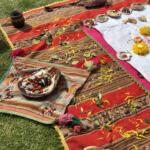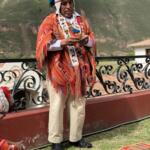To Peru, with love
Peru is one of those unique countries that you can enjoy in a variety of ways – as part of girls or guys group trip, an active yet amorous getaway or as a solo adventurer… for me I came to visit this country as part of a girls trip and it was one our group will never ever forget.
Day 1 –
Upon arrival in Cusco, we were met and privately transferred from the airport to Hacienda Sarapampa for lunch. Sarapampa is a word from the Quechua language meaning ‘cornfield’. Situated in a privileged location in the Sacred Valley of the Incas, the property is just 40 minutes from the city of Cusco and 5 minutes from the town of Pisac. Hacienda Sarapampa offers visitors the opportunity to have a unique cultural experience around traditions associated with corn production practices in an authentic and natural environment. The owners are wonderful loving people.
After lunch, we participated in an Andean ritual Offering/Payment to the Earth (Spanish pago a la tierra). For centuries, the ancient Peruvians who inhabited the upper Andean areas of the country, venerated the Pachamama or Mother Earth as a sacred goddess and giver of life. In Thanksgiving for the abundance of food, they held mystical ceremonies in which they made offering of native foods and animals, while invoking the Apu (Spirit of the mountain) and the Wilko (God of the fire). Despite this being an ancient ritual, it is still part of current Peruvian culture. After the ceremony, we checked into our first hotel, the Belmond Hotel Rio Sagrado.
Fronting the banks of the Urubamba River in Peru’s Sacred Valley, the Belmond Hotel Rio Sagrado evokes the atmosphere of an authentic Andean village. This boutique hotel offers 23 guest rooms, suites and villas, all beautifully furnished with Peruvian textiles, natural stone and wood, large terraces, and sweeping views of the majestic scenery. Suites add gardens and extra space, while two-story villas boast fireplaces, wild riverfront gardens and Andean stonework. The hotel offers both a fine dining and casual al fresco restaurant. Guests can also relax outdoors and sip one of the internationally renowned wines from the hotel bar. Other amenities include a spa with spacious indoor/outdoor Jacuzzi, steam room, sauna and yoga studio. Guests can also enjoy river rafting and horseback riding. Kids’ activities include table tennis, board games, art classes and petting the hotel’s baby llamas. Located one hour and 40 minutes by car from Cusco’s Alejandro Velasco Astete Airport, the Belmond Hotel Rio Sagrado is an excellent choice for guests looking to acclimatize at a lower altitude (9,400 feet).
Day 2 –
The next day we enjoyed a visit to an Andean highland community where we met the Quechua-speaking farmers and weavers of a rural Andean community, and had a personal encounter with local lifeways and traditions. At the magical and inspiring world of Quechua highlanders we learned how traditional people live today in the Andean countryside. We participated in the daily activities of the place that they call the village of beautiful flowers, visiting the kitchens to see a colorful variety of local foods on display, under preparation, and being cooked upon wood-fired mud-brick stoves. The welcoming and hospitable villagers offered us a demonstration of textile technique and design — an essential feature of Peruvian life for millennia. They shared this knowledge with us, and revealed the symbolic meanings encoded into their cloth and styles of dress. Then, after a short walk with our village companions to the accompaniment of flutes and drums, we entered the heart of the Andean agricultural cycle — as vital today as it was in Inca times — as our Quechua hosts showed us how they hand-turn the soil on the mountainsides, and invited us to join them in blessing their earth, their animals, and the new-plowed land. In this celebration of profound Andean traditions inherited from the Inca past, we gained a privileged experience for ourselves.
After our time at the Andean highland community we continued on to enjoy lunch at Wayra where we saw a Paso Fino horse farm and learned about the art of training these magnificent animals, prized for their elegant gait. We then enjoyed a demonstration by a stallion before continuing on to Ollantaytambo Fortress.
Ollantaytambo is a formidable stone structure climbing massive terraces to the top of a peak. This huge monument was the site of the Incas’ greatest victory against the Spanish. Constructed of rose-colored granite, Ollantaytambo was once a thriving complex of baths, temples, and military barracks. Below the fortress lies a complete Incan town, still inhabited with its original architecture and layout preserved.
To end our day we enjoyed a private tasting of Peru’s local drink, the Pisco Sour. Day 3-
After a full two days we set along the eastern slopes of the Andes, Machu Picchu was discovered in a hidden tangle of trees atop a mountain by American historian Hiram Bingham in 1911, when it was first made known to the outside world. And yet, this Lost City of the Incas with its walls, terraces and monuments that appear carved from continuous rock escarpments forever holds the secret of its passing; its Incan inhabitants left no written records of its purpose. Built in the 15th century at the height of the Inca Empire, it was most likely the estate of an emperor. Curiously, excavations here have revealed skeletons, artifacts and woolen clothing, but no gold. South America’s best-
known archeological site, a trek to Machu Picchu, set high in the clouds, is the highpoint of any adventure to Peru.
Early that morning we were transferred to the train station in Ollanta to begin a picturesque one and a half hour journey traveling along the Urubamba River with stunning views of the dramatic canyon, bound for Machu Picchu, one of the new Seven Wonders of the World.
We disembarked from the train to join the last section of the Inca Trail, head down to the River Vilcanota and over the bridge towards the archeological remains of Chachabamba; discovered in 1940, these ruins are on the old Inca road that followed the southern bank of the Urubamba River, part of an important religious site and a gatehouse guarding this entrance to Machu Picchu. We ascended the hillside through woods and open grassland to the splendid ruins of the Winay Wayna Inca Fortress, passing a beautiful waterfall and stopping for a rest and a box lunch under a shady tree.
We continued along the trail, contouring the mountainside through forest until we came to the almost vertical rock stairway to Inti Punku (the Sun Gate). We arrived to see the glory of the Inca Empire is spread out before us: Machu Picchu in all its splendor. We then descended from Inti Punku to the ruins. This three-mile hike took approximately 6 hours through beautiful scenery.
After our hike we enjoyed a relaxing massage in the Unu Spa. Unu Spa combines classic nurturing and a mystical Andean approach. The natural products used are derived from local botanical extracts.
For dinner that night we dined on 12 private acres of lush mountainside 70 miles northwest of Cusco, the Inkaterra Machu Picchu Pueblo Hotel meanders through winding paths, gardens and waterfalls. This boutique hotel offers 81 whitewashed casitas with rooms or suites decorated in warm terra cotta tiles, exposed eucalyptus beams and locally crafted decor. Other amenities include a restaurant, bar and spa. There you have the opportunity to enjoy cooking classes and special children’s activities. Set well off the beaten path, the Inkaterra Machu Picchu Pueblo Hotel is an excellent choice for families seeking a relaxing prelude to their Machu Picchu adventure.
Day 4-
On our fourth day we continued our explorations in this ‘Lost City ‘. We had the opportunity to hike to Huayna Picchu, the iconic mountain that towers over the ruins.
At lunch we enjoyed tea time and a buffet at the Machu Picchu Sanctuary Lodge. Some of us spent our afternoon continuing to explore the ruins while others explored the town of Aguas Calientes.
Later, we were transferred by bus to Aguas Calientes back to the rail station to board the Hiram Bingham train. On disembarking, we were transferred to our hotel.
Cusco is a lovely colonial city set high in the Andes at an altitude of 11,200 feet. Capital of the ancient Incan Empire as well as the modern-day region of Cusco, the city’s nickname as the navel of the world expressed its prominence in the eyes of the Incas and its location at the exact center of the Inca Empire. It remains the continent’s oldest and continuously inhabited city and also one of its most vibrant, with treasures that include the historic Plaza de Armas and its splendid Cathedral.
Occupying a former monastery and national monument dating from 1592, the Belmond Hotel Monasterio is a delightful retreat set just off of Cusco’s lively central square. The highlights of the stunningly restored grounds are the imposing 300-year-old cedar tree set in the center of its main courtyard and a gilded chapel hung with fine art. The hotel compliments its centuries-old charm with attentive service, inspired restaurants, and 122 boutique rooms and suites. Guests can also enjoy relaxing aromatherapy and reviving Thai massage treatments in the hotel’s Therapy Suite. Located 20 minutes from Alejandro Velasco Astete Airport, the Belmond Hotel Monasterio is the perfect choice for guests seeking a historic luxury property in the center of Cusco.
Day 5-
On our last full day following a morning at leisure, we spent the afternoon discovering Cusco on a half day city tour that included the Cathedral on the Plaza de Armas, known as one the most beautiful churches in the Americas. Its construction was influenced by the great Spanish cathedrals of the era, reflecting Gothic, Renaissance and Baroque styles. Another ornate church is Santo Domingo, a 16th-century Dominican church and convent built on the foundations of the Koricancha, the Incas’ principal religious building.
Later we explored the well-preserved ruins of Sacsayhuaman, a testament to Incan architectural skill. Compiled of massive stones, the walls were cut and placed together with incredible precision and without a single drop of mortar to hold them in place. This ancient fortress, where the greatest battle between the Spanish and Incas took place, overlooks the red-tiled roofs of Cusco and the spectacular lush countryside.
Built as an Inca ceremonial court around 1450 AD, the building that now houses the Museum of Pre Colombian Art also became the mansion of the conqueror Alonso Diaz in 1580 and the residence of the Earl of Cabrera in 1850. For dinner that evening we dined in the restaurant of the Museum, an extraordinary historic monument in Cusco.
Day 6-
Our journey came to an end after an amazing five days. Our highlights of Peru were undoubtably the food, the people, and the incredible vistas.
Features
- Peru

